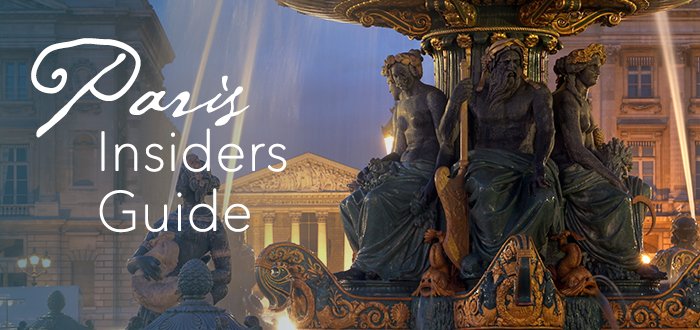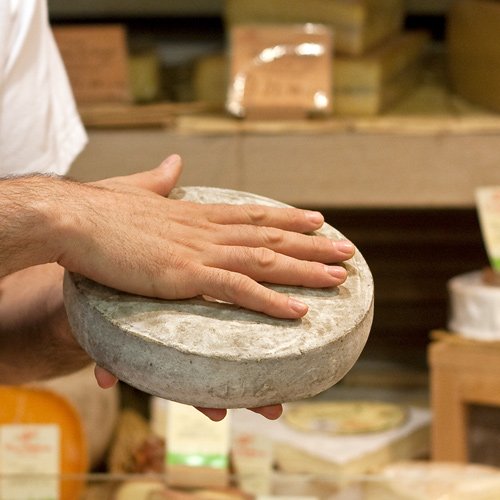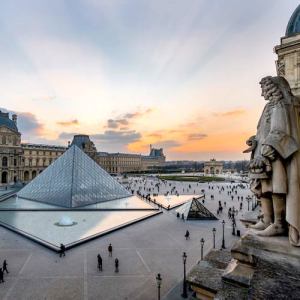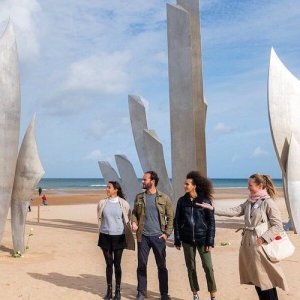Eleven Top-Rated Sculptures At Musée d'Orsay In Paris
Eleven Top-Rated Sculptures At Musée d'Orsay
When you enter Musée d'Orsay the first art you notice is the collection of sculpture filling the main hall, where trains once waited to journey to Orléans. With daylight streaming through the glass roof of this former train station, the Orsay Museum is an ideal space to see sculptures at their best. There are hundred of statues and busts at d'Orsay, let's look at some of the highlights.
![]()
Our Top-Rated Museum Tours in Paris
1. Louvre 2-Hour VIP Tour… This small-group option is the best experience
2. 3-Hour Louvre Semi-Private Tour… Feel like a VIP on a small group tour
3. Musée d'Orsay Impressionist Tour… The top-rated museum tour in Paris
4. The Paris Museum Pass… Free entry to over 60 museums and monuments
1. Liberty – Bartholdi
 Bartholdi, Liberty
Bartholdi, Liberty
A gift from France to the USA for the 100th anniversary of American Independence, the Statue of Liberty has since become famous around the world. The iconic memorial celebrates Franco-American friendship and was the result of the collaboration of Edouard Lefebvre de Laboulaye, the anti-slavery activist, who thought of the idea for the statue, and Frederic-Auguste Bartholdi the artist.
Bartholdi chose a classical model inspired by Neo-Classicism. The simple, austere form has meaningful symbols — the flaming torch is enlightenment, the tablet is law, and the broken chains represent servitude. The radiant crown was inspired by Canova's tomb of Pope Clement XIII in Rome. Bartholdi created a peaceful yet powerful image of the shared values of the two republics. As a final flourish, it was Gustave Eiffel who made the internal metal structure.
For two years the statue gradually rose from the foundry, towering above buildings in the 17th arrondissement. The inauguration was held in the New York Harbour on October 28, 1886. The small version at Musée d'Orsay was created by Bartholdi himself for the Paris Exposition Universelle of 1900. Afterwards, he gave the statue to the Musée du Luxembourg when that museum was home to 19th-century French art. Later it was relocated to the Jardin du Luxembourg. It was only in 2014 that this version was moved into Musée d'Orsay.
![]()
Discover What's On When You're Here...
• January... |
• February... |
• March... |
• April... |
• May... |
• June... |
• July... |
• August... |
• September... |
• October... |
• November... |
• December... |
Discover What's On When You're Here
• January...
|
• February... |
• March... |
|---|---|---|
• April... |
• May... |
• June... |
• July... |
• August... |
• September... |
• October... |
• November... |
• December... |
2. La Danse – Carpeaux
 Carpeaux, La Danse
Carpeaux, La Danse
|
 Carpeaux, Ugolin
Carpeaux, Ugolin
|
A French sculptor and painter during the Second Empire under Napoleon III, Jean-Baptiste Carpeaux (1827-1875) was very gifted and is still considered the greatest sculptor before Rodin. His wrenching representations of the human form were echoed in his turbulent personal life, filled with illness and violence.
In 1863 Charles Garnier, architect of the new Palais Garnier, commissioned four sculptors to decorate the facade of the opera house; one of these was Jean-Baptiste Carpeaux. Over a three-year period, Carpeaux produced many sketches and models before envisioning a farandole, an open-chain community dance of women, conveying the feeling of movement through circular and vertical motion. When it was unveiled, the public was outraged by the realism of the female nudes. The Palais Garnier version is shown to the left, above.
![]()
Romantic Dinner Cruises In Paris
|
VIP Dinner Cruise with Bateaux Parisiens |
Dinner Cruise by Maxim's of Paris |
|
VIP Dinner Cruise with Bateaux Parisiens |
3. Ugolin – Carpeaux
Considered Carpeaux's masterpiece, Ugolin was completed in 1861 at the end of his studies in Rome. The complex sculpture is based on Dante's Divine Comedy, where the poet describes Ugolino, the tyrant of Pisa, chained in the Tower of Hunger. When his children see him gnawing his hands, they offer themselves to be devoured. Each element underwent many sketches and some think the work depicts Carpeaux himself, tormented by the act of creation and by his own demons. Right photo above.
4. Napoleon I As a Roman Emperor – Barye
 Barye, Napoleon I As a Roman Emperor, photo by Mary Ann Sullivan
Barye, Napoleon I As a Roman Emperor, photo by Mary Ann Sullivan
You just know that Napoleon would have loved this idea — an equestrian statue, with him sitting as majestic as Augustus. Unfortunately for Bonaparte he'd been dead forty-four years by the time Antoine-Louis Barye started this sculpture. Barye had studied animals in the Jardin des Plantes and comparative anatomy in the Natural History Museum alongside Delacroix. His animal drawings are lively and dramatic, but the sculptor also had a taste for the classical, like here, in this model for a monument to Napoleon I.
Barye used a toga and Roman equestrian styling to express imperial majesty. In the finished monument, this impressive figure rose up between life-sized statues of the four Bonaparte brothers. Although Barye was considered too romantic for official exhibitions, he did receive a commission for the July Column. (He created the bas-relief of a lion on the base of the column, still seen on Place de la Bastille.)
![]()
Two Of The Most Popular Paris Experiences
|
VIP Dinner Cruise with Bateaux Parisiens |
Versailles with Priority Access + Gardens |
The Most Popular Paris Experience
|
VIP Dinner Cruise with Bateaux Parisiens |
5. Hercules the Archer – Bourdelle
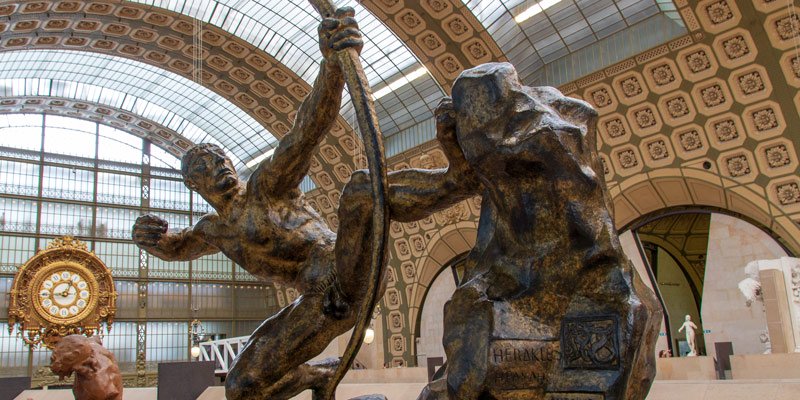 Bourdelle, Hercules the Archer, photo by Mark Craft
Bourdelle, Hercules the Archer, photo by Mark Craft
Emile-Antoine Bourdelle worked as an assistant in Rodin's studio; the two men were bound together by mutual admiration and respect. Unlike Rodin, Bourdelle aimed to simplify his lines: "Contain, maintain and master are the rules of construction," he taught his pupils. Hercules the Archer gave Bourdelle the chance to experiment on a large scale and the piece is remarkable for its tension and balanced construction.
6. Walking Panther – Bugatti
 Bugatti, Walking Panther
Bugatti, Walking Panther
furniture designer Carlo Bugatti and the brother of the automobile manufacturer Ettore Bugatti, was a gifted child and took up animal sculpture at an young age. Success came to him quickly; in 1907, the Royal Society of Zoology invited him to live in Antwerp, to draw animals in their zoological gardens.
Bugatti was so fond of the animals that he was allowed to feed and care for them. He loved to sculpt exotic mammals, birds, reptiles, and was particularly fond of wild cats; this panther is a good example of his style. Plagued by depression, Bugatti was traumatized by the outbreak of World War I and had to return to Paris. The zoo was closed and, deprived of the company of animals, Bugatti took his life in 1916 at the age of thirty-two. Located in room 62 of the museum.
![]()
The Highest-Rated Paris Activities
|
Cheese & Wine Tasting in a Paris Cellar |
VIP Dinner Cruise with Bateaux Parisiens |
|
VIP Dinner Cruise with Bateaux Parisiens |
7. The Four Parts of the World Holding the Celestial Sphere
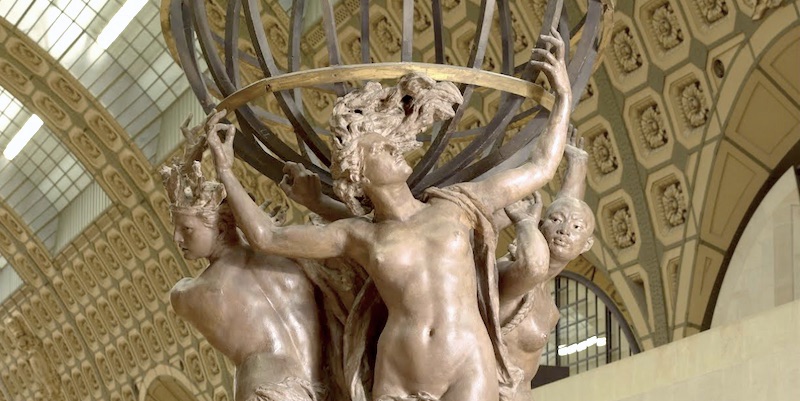 Carpeaux, The Four Parts of the World
Carpeaux, The Four Parts of the World
It was Baron Haussmann who, in 1867, commissioned Carpeaux to design a fountain for the Observatoire garden. Carpeaux chose the theme the four parts of the world turning around the celestial sky. The sense of movement is where Carpeaux's talent shines. His passionate sculpture was contrary to the Neoclassic serenity popular at the time. It was not until 1874, a year before Carpeaux died, that the bronze fountain was set up on the designated site at the south end of the Jardin du Luxembourg. Detail crop shown above.
8. The Mediterranean – Maillol
 Maillol, The Mediterranean
Maillol, The Mediterranean
In 1905 when Aristide Maillol's sculpture was exhibited at the Salon d'Automne it caused a sensation; critics thought the sculpture was beautiful, yet banal. The Musée d'Orsay has two versions — the bronze one is a recent casting while the marble was made during Maillol's lifetime. The statue's beauty lies in its simplicity; Maillol's approach was the opposite of Rodin — he shows no excessive emotion or straining muscles. The figure, a set of interlocking triangles, is folded in on itself as if in thought.
![]()
Find Hotel Deals for Your Dates in Paris
Check the complete list of Paris hotels to find current sale prices on rooms in every arrondissement. Save 10%, 20%… or even more! |
Paris Hotel Deals |
Find Hotel Deals for Your Dates in Paris
Save on hotels in every arrondissement of Paris – the Latin Quarter, Saint Germain, the Right Bank, the Marais, near the Eiffel Tower. Save 10%, 20%… or even more! |
9. Woman with Lilies – Seysses or Mucha?
Born in Toulouse in 1862, Auguste Seysses trained with the sculptor Falguière, followed by a successful career. Artist Alphonse Mucha (1860-1939), best known today for his Art Nouveau posters, would call on Seysses when he needed an assistant capable of finishing a project — Mucha, for instance, was not a trained sculptor.
So, is Woman with Lilies a Seysses or a Mucha? It shows many similarities to Mucha's works, including a poster from 1896 of Sarah Bernhardt standing with a crown of lilies in her hair, as well as other Mocha designs with young women and lilies. Jiri Mucha, Mucha's son, found among his father's papers a photograph similar to the Woman with Lilies, showing a model standing naked, with branches in her arms and flowers in her head. Jiri wrote, "My father may have sketched the overall idea and let Seysses finish it. Or perhaps he started work on it, on the face and hands and left the rest to Seysses."
10. La Pensée – Rodin
 Rodin, La Pensée
Rodin, La Pensée
Camille Claudel — Auguste Rodin's star pupil, lover, and successful sculptor in her own right — was also often his model. When working on this sculpture, Rodin was inspired to leave the area below Claudel's head undone to reflect its original title, Thought Emerging from Matter. With her face tilted forward, in shadow, she seems to be plunged in reverie. The contrast between the polished flesh and the rough-hewn block intensifies the impression of the personification of thought emerging. Rodin gifted it to Musée du Luxembourg in 1902. Located in the Orsay's Galerie Françoise Cachin.
![]()
The Best Evenings in Paris
|
Dinner & Cabaret at the Moulin Rouge |
VIP Dinner Cruise with Bateaux Parisiens |
|
Dinner & Cabaret at the Moulin Rouge |
11. David – Mercié
The year was 1870 and France's defeat in the Prussian war left the country feeling humiliated and longing for revenge. The Biblical story of David was taken as an sign that, one day, France might slay the Prussian Goliath.
The sculpture was an instant success. The plaster model was completed in Rome, where Antonin Mercié was finishing his training; it earned him the Legion of Honour. A bronze version was commissioned by the French government and was placed in the Musée du Luxembourg in 1874. It soon became one of the most popular images in popular French culture; miniature versions, in six different sizes, were produced and sold throughout the country.
How Sculpture Flourished at the Orsay

Sculpture as an art form flourished in the 19th century when the newly-affluent bourgeois decorated their new homes and gardens with sculptures. Politicians and statesmen, too, saw stone and bronze as a way to proclaim their status. No public building was complete without a display of statuary.
After World War II artists and patrons moved away from sculpture, thinking it was too stuffy, old fashioned. Many works, now out of date, were put into purgatorial storage that would last decades. Only a few major artists, like Rodin, escaped the malaise. Finally, in 1986, the conversion of the Orsay railway station into a museum created a new home for these sculptures. The massive, arched glass ceiling perfect illuminates the museum's sculpture displays.
Paris Planning Guides
 Book an Airport Transfer
Book an Airport Transfer |
 Skip the Tower Lines
Skip the Tower Lines |
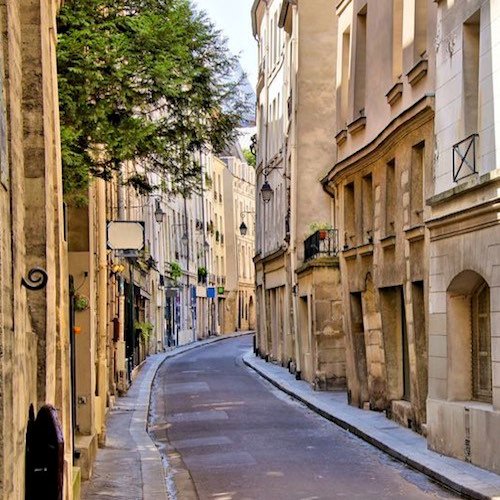 Latin Quarter Guide
Latin Quarter Guide |
 Glorious Dinner Cruises
Glorious Dinner Cruises |

